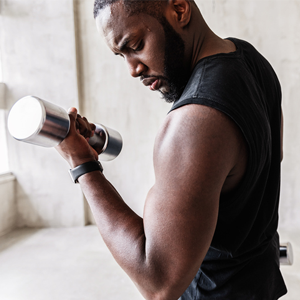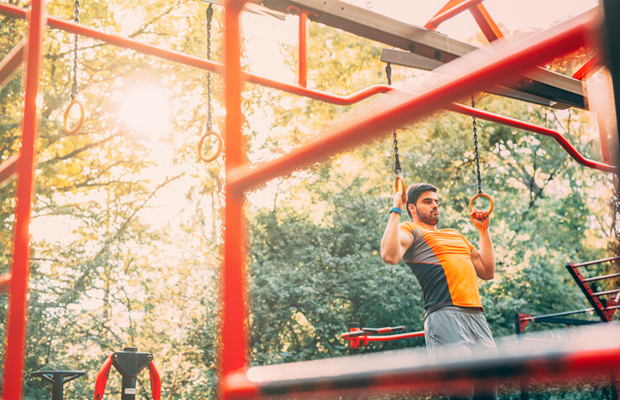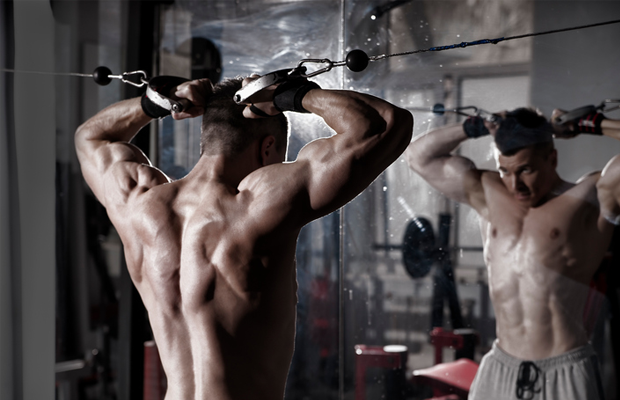
Let’s be honest, you probably went to bed last telling yourself you would go to gym at some point today.
Maybe you just can’t bring yourself to go or perhaps it’s been a few days of planning to go and then coming up with every excuse possible as to why you can’t.
Whatever, you’re telling yourself, it’s too early in the year to abandon the promises you made on 1 January.
Read more: 61 small habits you can change to lose weight
Here are 10 ways you can get back on the road to ripped:
1. Switch to body-weight training
All the instruments of weight training have their place – no one’s claiming they don’t. But there’s a buzz to be had from ditching them for a while and instead, using the oldest and greatest muscle-sculpting tool at your disposal: your own body.
What’s so good about a programme comprised exclusively of body-weight exercises? Let’s count the ways.
Aesthetics. Get it out of your head that body-weight exercises are a soft option that won’t yield much by way of results.
“Look at gymnasts,” says personal trainer Paul Haslam. “They never lift weights. They never do biceps curls or triceps push-downs. Yet they’ve got massive guns and the best bodies of any type of athlete bar none.”
Haslam argues the human musculature responds better to real-world movements, like the kind our ancestors used to climb trees and carry pales of water back to camp, than to contrived exercises like lat pulldowns.
Read more: 5 secrets to increasing size and strength with body-weight exercises
Variety. You’re not just swapping benching for push-ups. You’re swapping it for a combo of standard push-ups, push-ups with legs elevated on a chair, push-ups with clap and Rocky’s signature one-armed variation.
It’s the same with chin-ups: vary your hand position and grip width to target every muscle in the back.
“You don’t even need a chin bar,” says Haslam. “I’ve used garage beams, branches – anything you can get a grip on.”
Practicalities. With no need for equipment you can train in the park (or in your living room) while saying adios to gym fees, queuing for apparatus and fiddling with poundages.
And don’t worry – that hot instructor will probably still be there when you go back. That’s if you go back: the purity of body-weight training, once experienced, is like the call of the siren.

2. Swap gyms
If you’ve been working out for so long in the same gym that you know the serial number of your preferred squat rack, it’s time to think about a change of venue.
“There’s a big advantage to be gained from being a gym slut,” says Haslam.
Read more: How to not look like the new guy at the gym
“Your form always improves when you start at a new place because you can’t help showing off.” Paul Johnstone, gym owner, says many of his hardcore trainers split their time between his gym and another one. “This allows them to choose their gym for a particular session based on how they’re feeling,” he says.
On a given day, they may want to be around a bunch of guys who’ll rev them up, or they may prefer to be left alone. Having that choice protects them from falling into a rut.
3. Change the scenery
Keeping running interesting is a challenge. Few guys understand this better than Ben St Lawrence, Australia’s 5 000m and 10 000m national champion, who in a heavy week will cover more ground than Burke and Wills.
A St Lawrence tactic for keeping things fresh is regularly changing his running venue, from his usual spot in the city to, to the mountains for instance.
“I’ll hit the trails in the mountains – that’s rough ground and tough hills,” he says.
Read more: 4 backyard items you can use as weights for workouts
He also breaks up the grind with interval work, adjusting his speeds and the duration of his rest periods from session to session.
“Running is a such a repetitious sport,” he says, “but there are so many different places you can run and so many different sessions you can do. And it feels like you’re doing something completely different, even though you’re still putting one foot in front of the other.”
Olympian Courtney Atkinson, a three-time winner of the Noosa Triathlon, is another who knows the restorative value of a new setting.
While he likes routine, he’s not the Rain Man. “I get bored riding on the roads, so for me it’s a nice change to ride indoors on a stationary bike,” he says. “I can have music blaring and disappear into my own world.”
He’ll take his swim training from the pool to the ocean to the lake, and his running from the road to the track to the forest to the beach.
"My golden rule is that if you’re feeling bored and fatigued, it might not be that you’re overtraining, it’s probably just that you need a change.”
Atkinson suggests that if you’re a morning runner, try some night sessions, “You’ll feel like you’re moving quicker.” It’s pouring out there? Even better.
“Once you get through the first two minutes of getting soaked to the skin, there’s no better feeling.”

4. Narrow your focus
Nothing makes a bigger dent in your training than a sense that, despite attacking your iron workouts like Scooby Doo attacks a sandwich, your hard work hasn’t transformed your physique as you feel it should have.
The answer could be to pare back your muscle plan to a single objective, argues Greg Stark, founder of Better Being personal training.
A lot of guys want to stack on bulk in their chest and shoulders while simultaneously unveiling a six-pack. But for most guys these goals are mutually exclusive because of the different nutritional imperatives associated with each, explains Stark.
“You’d do much better to say that for next three months I’m going to work on getting bigger, then for the three months after that I’m going to concentrate on cutting body fat and ripping up,” he says.
Both for upping motivation and getting results, guys tend to respond well to this strategy, known as periodisation, because it recruits science into your workouts while uncluttering your mind.
5. Hit your weak points
You could undertake no nobler shake-up than to target your weaknesses. It’s noble because you don’t want to do it, do you? Who would? Who wants to devote themselves to something that highlights your frailties and hurts like unrequited love?
“Making the decision to overcome a weak point can take a great deal of moral courage,” Arnold Schwarzenegger once observed.
As an emerging bodybuilder Arnie cut off the bottoms of his sweatpants to expose his relatively puny calves. He wanted to confront his flaw while he set about fixing it.
As a guy who works out, your most likely weakness could be poor flexibility or legs that are underdeveloped compared to your upper torso. Or you may be able to cruise through a half-marathon, but can’t crack 16 seconds for the hundred.
“We gravitate towards activities of least resistance,” says Stark. Take most guys into a gym and they’ll lift weights, while most women will do a yoga class. “It should be the other way around."

Read more: 5 surprising ways to make your biceps grow
If fitness can be broken down to speed, endurance, strength and flexibility, a rule of thumb is you should spend the same amount of time per week on each component. But for this shake-up, give your weak point priority until you’ve brought it up to speed.
Every six weeks at Johnstone’s gym a group of weight trainers assembles to appraise one another’s physiques. In most cases, the body part most lagging is legs.
“Some guys panic at the thought of leg workouts because they’re brutal,” says Johnstone. For these guys, relatively frequent, medium-intensity sessions are a better option than a single, massive leg workout each week.
“Lighter sessions won’t get them huge but they show them they can do legs, and 95% of guys will make gains from that point.”
A programme targeting your deficiencies will yield unexpected benefits, says Original Bootcamp founder Chief Brabon, a distance runner who’s lately been doing a lot of sprint work since facing up to the fact that it’s his weakness.
“But the thing is, it’s improved all my running,” he says. “It’s also shaken up the way my musculature responds to stimuli. I can now put on lean muscle, which I’ve never been able to do in the past.”
6. Dive into the unknown
Instead of tinkering at the edges of your usual activity, ditch it in favour of something you’ve never tried before, like power yoga or a CrossFit workout.
The beauty of fitness activities like CrossFit is they force you to tax multiple energy systems, argues Brabon – you won’t be just a runner, sprinter or weight trainer anymore.
“Guys who come from the gym into outdoor training that involves more athletic-based movement… they begin shifting their focus from the way they look to how they perform,” says Brabon.
“It’s probably the biggest change in our industry the last five years. People are moving away from aesthetics and realising they can look good and perform as well, rather than flexing in front of a mirror and keeling over when they have to walk up a flight of stairs.”
7. Fatten the barbell
Here’s a simple shake-up that could have you getting mistaken for Popeye within six weeks. Training with thick-handled equipment isn’t a new idea – Alan Calvert, a pioneer in weight-training methodology, recommended it in 1924 in his book Super Strength – but it’s never caught fire. It deserves to.
The theory behind it is that, at a diameter of 25mm, standard barbells and dumbbells are too easy to use – keeping hold of them doesn’t thoroughly test the capacity of your lower arms.
“Thicker bars are best for developing size and strength in the forearms, which are often neglected,” says Haslam.
Thick-grip advocate Charles Poliquin, a Canadian who has trained Olympic medallists in multiple sports, goes further saying those who commit to using thick-handled equipment can, within weeks, handle 10-12% more weight across a range of exercises.
To add a twist to your workouts, and ask new questions of your body, start training with an Olympic barbell, which is twice the thickness of a standard bar.

Read more: The one move that'll boost your lifting power
8. Turn your workout upside down
If your workout’s as tired as a politician in a roadshow, flip it on its head. Literally. Start with swapping all your shoulder exercises for the handstand push-up.
“I’m a big fan of this advanced move for working all three heads of the deltoid in one hit,” says Haslam. Chances are you’ll need to work towards putting together multiple reps of this doozy, starting by holding a handstand for 20 seconds with your feet against a wall.
Any controlled movement that puts your backside above your head (from the classic forward roll to somersaults in a swimming pool) has the effect of improving your proprioception – your sense of where you are in space.
It’s a quality gymnasts have in spades. “Honing yours will improve your performance in whatever sport you do,” says Haslam.
In the spirit of doing the unfamiliar, add moves like the bear walk to your cardio and core routine – or better still, the reverse bear walk, suggests Brabon.
With moves like this, “You have to work out not only how to support yourself on those smaller muscle groups, but then how to propel yourself forward or backwards or sideways,” he says. “It’s all about explosively utilising muscles that we normally ignore.”
9. Lose your shoes
Yes, this is a controversial issue that still has a long way to, er, run. But the view gaining momentum in athletic and research circles is that running barefoot or in minimalist footwear on natural surfaces is better for your body than thumping about in heavily-cushioned shoes. At the very least it’s a different experience, which is more to the point.
“Run barefoot and you’ll immediately have this sense of being free,” says podiatrist and long-distance runner Jason Agosta. “It’s something exhilarating you have to try.” As St Lawrence sees it, nature designed the foot for running, which kids do effortlessly in bare feet. Some years ago, when St Lawrence became serious about running, his mum lashed out on “motion-control” shoes.
Read more: The average guy's guide to trying yoga for the first time
But before long his knees ached and he ditched the fancy runners for a more neutral pair. Nowadays, he trains in a handful of pairs with varying levels of padding, but they mostly look and feel like ballet slippers compared to the clodhoppers you’re probably pounding the pavement in.
“I like to go barefoot on grass, especially warming down at the end of a session,” St Lawrence says. “It helps with any Achilles pain and takes the pressure off your toes.”
The problem with most running shoes, argues Agosta, is they dull your perception of the ground, blocking the muscular activation in your calves that acts as a shock absorber.
Claiming that shoe companies have “brainwashed” people to believe “that we need fatness and softness between us and the ground,” Agosta urges a gradual transition to minimalist footwear – very gradual if you’ve been wearing the heavily-padded type for donkeys.

10. Try a new prop
Okay, we’ve already discussed garaging all your equipment. But you could go the other way and add a new item – and it needn’t be high-tech or expensive. In fact, the more basic the better. It’s like what Apollo Creed told a jaded Rocky in Rocky III about getting back the edge, “The way to get it back is to go back to the beginning.”
Brabon suggests hot footing it to your local hardware store for a bag of sand.
“Think about it,” he says. “Some of the fittest guys you see walking down the street, what are they? They’re labourers. And what do they all day? Throw a frigging bag of cement over their shoulder and take it up a ladder.
“The point is you’re needing to maneouver a dead weight that’s unwieldy, forcing you to recruit dormant muscles,” says Brabon.
More retro options: skipping rope, chest expander, kettle bell, monkey bars, punching bag, hand grippers, medicine ball. And sweat it out in a singlet for extra old school cred.
This article was originally published on www.menshealth.com
Image credit: iStock




 Publications
Publications
 Partners
Partners










